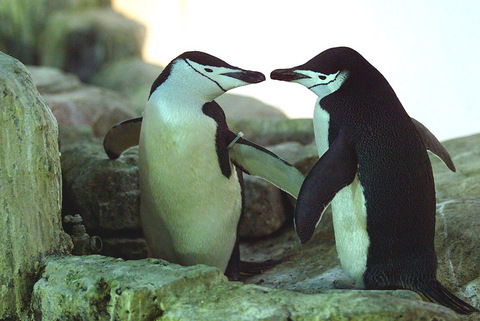Giraffes mounting, aroused whales mating and dragonflies copulating — perfectly normal, tender scenes — although perhaps not for all, as in this case these animals are of the same sex.
Breaking what is taboo for some, the Oslo Natural History Museum is currently showing an exhibition on homosexuality in the animal kingdom, which organizers say is the first of its kind in the world.
“As homosexual people are often confronted with the argument that their way of living is against the principles of nature, we thought that ... as a scientific institution, we could at least show that this is not true,” exhibition organizer Geir Soeli said. “You can think whatever you want about homosexuals but you cannot use that argument because it is very natural, it's very common in the animal kingdom.”

PHOTO: NY TIMES NEWS SERVICE
From beetles to swans and creatures considered to have a more macho image, such as lions and sperm whales, homosexual behavior has been detected in 1,500 species.
The exhibition, entitled Against Nature?, displays examples of this behavior in pictures and models.
In one image two female adult bonobo chimpanzees are having sex, oblivious to a young male who is attempting to join in.
These peaceful primates — with whom man shares 99 percent of his genetic makeup — use sex as a stress reliever regardless of age and gender barriers.
Be it a one-off, occasional or seasonal, homosexual and bisexual contact in the animal kingdom serves different purposes.
Big horn sheep “need to have sex with their own fellows just to be accepted. And by being accepted they are making up very important social relations which later give them better access to females,” Soeli said.
Among swans and flamingos there have been cases of two females living together using sexual contact with males purely to reproduce.
“One of them might have a small affair with a male, have her eggs fertilized, and the two females bring up the young birds together just as a family,” Soeli said.
It has been reported that in certain bird species males double up allowing them to control a larger territory than a heterosexual couple, which in turn serves to attract more females.
The first documented cases of supposed homosexuality in animals date back to the Greek philosopher Aristotle who, more than three centuries before Christ, was intrigued by the promiscuity of male hyenas.
The subject was then ignored for many centuries, with incidents of male coupling described as part of fighting rituals.
“They did not describe it as homo-sexual activity, or as the result of lust,” Soeli said. “But animals have strong instincts ... . Maybe they're having sex just because it's good.”
While the images displayed at the Natural History Museum wash over passing school children, the exhibition has sparked consternation in conservative Christians.
A Lutheran priest said he hoped the organizers would “burn in hell,” and a Pentecostal priest lashed out at the exhibition saying taxpayers' money used for it would have been better spent helping the animals correct “their perversions and deviances.”

May 26 to June 1 When the Qing Dynasty first took control over many parts of Taiwan in 1684, it roughly continued the Kingdom of Tungning’s administrative borders (see below), setting up one prefecture and three counties. The actual area of control covered today’s Chiayi, Tainan and Kaohsiung. The administrative center was in Taiwan Prefecture, in today’s Tainan. But as Han settlement expanded and due to rebellions and other international incidents, the administrative units became more complex. By the time Taiwan became a province of the Qing in 1887, there were three prefectures, eleven counties, three subprefectures and one directly-administered prefecture, with

Taiwan Power Co (Taipower, 台電) and the New Taipei City Government in May last year agreed to allow the activation of a spent fuel storage facility for the Jinshan Nuclear Power Plant in Shihmen District (石門). The deal ended eleven years of legal wrangling. According to the Taipower announcement, the city government engaged in repeated delays, failing to approve water and soil conservation plans. Taipower said at the time that plans for another dry storage facility for the Guosheng Nuclear Power Plant in New Taipei City’s Wanli District (萬里) remained stuck in legal limbo. Later that year an agreement was reached

What does the Taiwan People’s Party (TPP) in the Huang Kuo-chang (黃國昌) era stand for? What sets it apart from their allies, the Chinese Nationalist Party (KMT)? With some shifts in tone and emphasis, the KMT’s stances have not changed significantly since the late 2000s and the era of former president Ma Ying-jeou (馬英九). The Democratic Progressive Party’s (DPP) current platform formed in the mid-2010s under the guidance of Tsai Ing-wen (蔡英文), and current President William Lai (賴清德) campaigned on continuity. Though their ideological stances may be a bit stale, they have the advantage of being broadly understood by the voters.

In a high-rise office building in Taipei’s government district, the primary agency for maintaining links to Thailand’s 108 Yunnan villages — which are home to a population of around 200,000 descendants of the Chinese Nationalist Party (KMT) armies stranded in Thailand following the Chinese Civil War — is the Overseas Community Affairs Council (OCAC). Established in China in 1926, the OCAC was born of a mandate to support Chinese education, culture and economic development in far flung Chinese diaspora communities, which, especially in southeast Asia, had underwritten the military insurgencies against the Qing Dynasty that led to the founding of